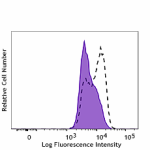- Clone
- S21005B (See other available formats)
- Regulatory Status
- RUO
- Other Names
- ARK, AXL receptor tyrosine kinase, AXL transforming sequence/gene, AXL oncogene, JTK11, Tyro7, tyrosine-protein kinase receptor UFO
- Isotype
- Mouse IgG1, κ
- Ave. Rating
- Submit a Review
- Product Citations
- publications

-

Human peripheral blood mononuclear cells were stained with an anti-human lineage cocktail of CD3, CD19, CD14, and CD15 APC, anti-human CD303 (clone 201A) Brilliant Violet 421™ and anti-human AXL (clone S21005B) PE (left) or mouse IgG1, κ PE isotype control (right). Data shown was gated on the lineage-negative population.
| Cat # | Size | Price | Quantity Check Availability | Save | ||
|---|---|---|---|---|---|---|
| 386203 | 25 tests | £117 | ||||
| 386204 | 100 tests | £250 | ||||
AXL, also known as ARK or UFO, is a widely expressed glycoprotein in the TAM (Tyro3/Dtk, AXL, and Mer) receptor tyrosine kinase family. AXL is highly expressed in solid cancers. It is also expressed on a small population of human dendritic cells that share characteristics of classical and plasmacytoid dendritic cells. AXL binds the vitamin K-dependent growth arrest specific 6 (Gas6) protein and induces receptor autophosphorylation and downstream signaling pathways that are related to cell proliferation, migration, or apoptosis. AXL is also involved in hematopoiesis, embryonic development, tumorigenesis, and regulation of testicular functions. Recent studies have also shown that AXL and Mer are both linked to Alzheimer's disease.
Product DetailsProduct Details
- Verified Reactivity
- Human
- Antibody Type
- Monoclonal
- Host Species
- Mouse
- Formulation
- Phosphate-buffered solution, pH 7.2, containing 0.09% sodium azide and BSA (origin USA)
- Preparation
- The antibody was purified by affinity chromatography and conjugated with PE under optimal conditions.
- Concentration
- Lot-specific (to obtain lot-specific concentration and expiration, please enter the lot number in our Certificate of Analysis online tool.)
- Storage & Handling
- The antibody solution should be stored undiluted between 2°C and 8°C, and protected from prolonged exposure to light. Do not freeze.
- Application
-
FC - Quality tested
- Recommended Usage
-
Each lot of this antibody is quality control tested by immunofluorescent staining with flow cytometric analysis. For flow cytometric staining, the suggested use of this reagent is 5 µL per million cells in 100 µL staining volume or 5 µL per 100 µL of whole blood. It is recommended that the reagent be titrated for optimal performance for each application.
- Excitation Laser
-
Blue Laser (488 nm)
Green Laser (532 nm)/Yellow-Green Laser (561 nm)
- Application Notes
-
Clone S21005B recognizes a different epitope compared to clone S21005C.
Clone S21005B can block GAS6 induced AKT and ERK phosphorylation in H1299 cells.
Antigen Details
- Structure
- Transmembrane protein with two fibronectin type-III domains, two Ig-like C2-type domains, and one tyrosine kinase domain
- Distribution
-
Highly expressed in solid cancers and also expressed on human blood plasmacytoid dendritic cells and myeloid dendritic cells
- Function
- Binding of Gas6 induces receptor autophosphorylation and downstream signaling pathways that are related to cell proliferation, migration, or apoptosis. It is involved in hematopoiesis, embryonic development, tumorigenesis, and regulation of testicular functions. Recent studies have also shown that AXL and Mer are both linked to Alzheimer's disease.
- Ligand/Receptor
- Gas6 and Protein S
- Cell Type
- Dendritic cells, NK cells
- Biology Area
- Apoptosis/Tumor Suppressors/Cell Death, Cardiovascular Biology, Cell Death, Cell Proliferation and Viability, Immuno-Oncology, Signal Transduction
- Molecular Family
- Cytokine/Chemokine Receptors, Cytokines/Chemokines
- Antigen References
-
- Holland S, et al. 2005. Canc Res. 65:9294-303.
- Lee WP, et al. 2002. Oncogene. 21:329-36.
- Demarchi F, et al. 2001. J Biol Chem. 276:31738-44.
- Gene ID
- 558 View all products for this Gene ID
- UniProt
- View information about AXL on UniProt.org
Related FAQs
- What type of PE do you use in your conjugates?
- We use R-PE in our conjugates.
Other Formats
View All AXL Reagents Request Custom Conjugation| Description | Clone | Applications |
|---|---|---|
| Purified anti-human AXL | S21005B | FC,Block |
Compare Data Across All Formats
This data display is provided for general comparisons between formats.
Your actual data may vary due to variations in samples, target cells, instruments and their settings, staining conditions, and other factors.
If you need assistance with selecting the best format contact our expert technical support team.
 Login / Register
Login / Register 














Follow Us